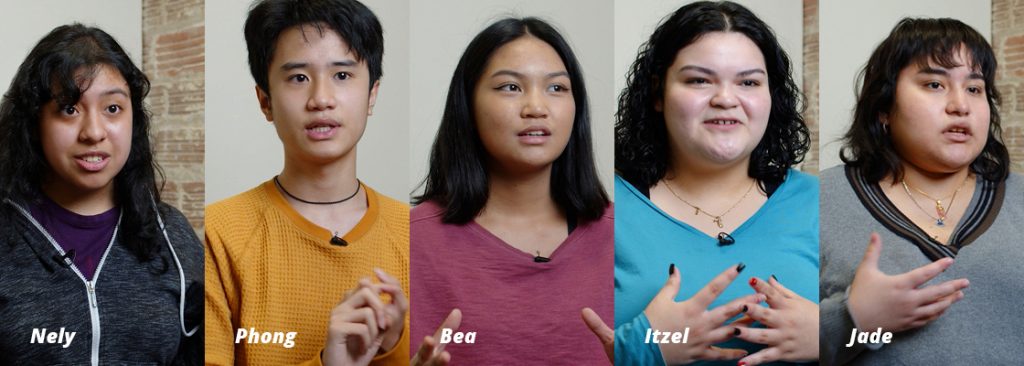VOICES: APTP TEEN ARTISTS ON PORT OF ENTRY

“The most important thing to know about Port of Entry is that these are real stories and these stories are gathered by us,” APTP teen artist Itzel Espino responds without hesitation when asked what she wants to share about the new immersive theater production that APTP’s teen ensemble will premiere in 2022/23.
Here five teen ensemble members who’ve been part of Port of Entry since 2018 reflect on the significance of this ambitious, multiyear creative journey.
What makes Port of Entry important?
Phong Nguyen: It’s super important to tell the stories of Albany Park because it lets people know that our community has so much to give to the city of Chicago and we’re such an anomaly compared to the segregation in most of Chicago, because here in Albany Park we have so many different cultures that live among each other.
Nely Gonzalez: Personally it is important to me to tell the story of immigrants because both my parents are immigrants, and they’ve struggled. I know my mom had to leave three of her children behind in her home country to be able to come to America to just earn enough money to provide for them. There are so many people struggling. I want to be able to share that story with everyone, that people who are immigrating here, they’re not trying to steal your jobs, they’re not trying to hurt anyone. They’re just trying to survive.
Jade Trejo Tello: In movies and TV shows there’s a lot of taking of stories without honoring them. There’s a kind of capitalizing off of and using people’s stories for profit. In Port of Entry, we make sure that people from our community come across as humans instead of accessories.
Bea Gigante: APTP and Port of Entry have really made me embrace my immigrant identity and that it’s not something I should be ashamed of. Sharing these stories is special to me because I feel like it discloses a little about my life and other immigrants’ experiences and shows how important we are.
Itzel Espino: Port of Entry is like a capsule of so many different cultures that share similar experiences and values, and audiences get to see the day-to-day life of those cultures and you get to see the similarities and differences between all these cultures.
Nely: It’s important also to preserve these community stories through Port of Entry during a time of gentrification.
Itzel: We know change will happen, but I think it’s so important to remember these stories and pass them down. While things may change and they won’t look the same as they used to, you still have those memories and you still have those stories kept with you.
Phong: If it’s not told in history books, then it has to be told somewhere else. And I think that’s a great facet of what APTP is doing.
Nely: Port of Entry is a way of holding these special stories and being able to share them with everyone who comes to see it.
What makes immersive theater special for performers and for audiences?
Phong: The beauty of immersive theater is that it allows for an intimate experience. It allows me to build a more personal connection with the audience member and it allows them to kind of enter my world or the world of the story I’m telling much more deeply.
Itzel: The biggest difference between an immersive show and a regular play, I feel, is the connection. You really feel heard and seen. It’s just a really cool experience because it’s so personal. So like I’ll literally be performing and I’ll have an audience 10 inches away from me and I just have to engage with them, and there’s power that comes with that.
Bea: Immersive theater is special for audience members because they’re able to actually be in the space, they get to travel to these different places. In a way, they’re a part of the story without actually being a part of it.
Parting Thoughts
Itzel: As a performer, I hope that the audience leaves heard, loved and connected. I hope that they feel happy that they spent time with us.
Nely: Port of Entry may, hopefully, open some eyes. Like, hey, there’s more than just your field of vision. Everyone has different perspectives. There are people, other people, living. And they’re going through so many different things. I gotta take that into consideration. Like hey, you’re struggling. I may not know why you’re struggling. But you know what? I’m here, as a neighbor, and I want to help. And that’s what I hope that Port of Entry shows to people.t spring, one of our Port of Entry dreams came true: the Reva and David Logan Foundation purchased a vacant Albany Park commercial building for APTP to create Port of Entry’s immersive world.
